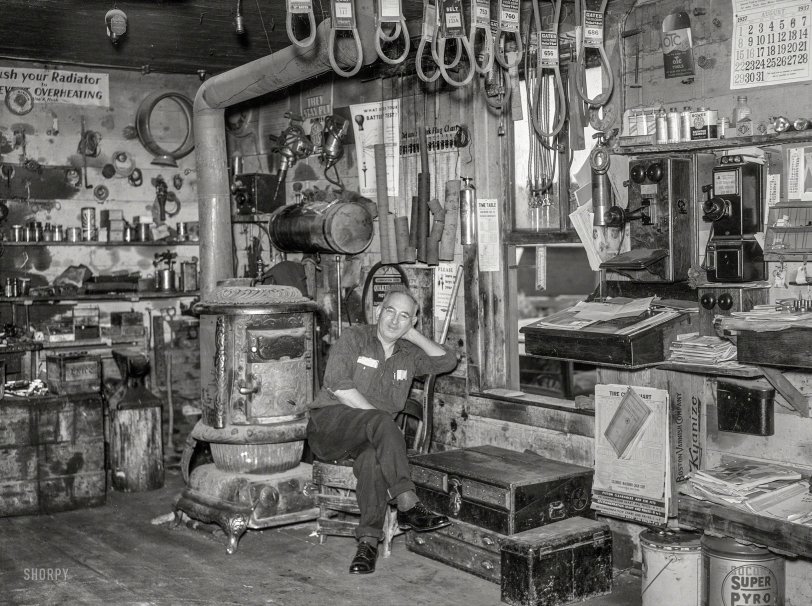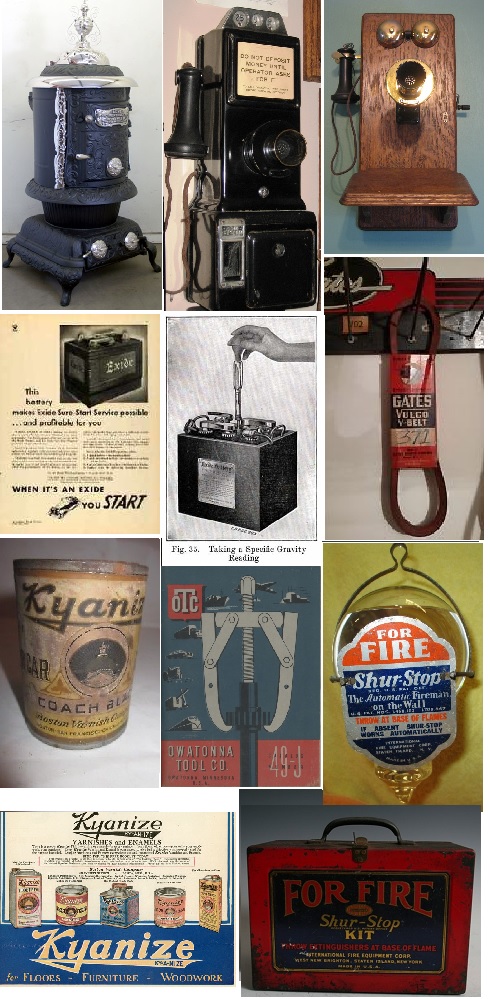


Framed or unframed, desk size to sofa size, printed by us in Arizona and Alabama since 2007. Explore now.
Shorpy is funded by you. Patreon contributors get an ad-free experience.
Learn more.

- Tough Guys
- Lost in Toyland
- And without gloves
- If I were a blindfolded time traveler
- Smoke Consumer Also Cooks
- Oh that stove!
- Possibly still there?
- What?!?
- $100 Reward
- Freeze Frame
- Texas Flyer wanted
- Just a Year Too Soon
- WWII -- Replacing men with women at the railroad crossing.
- Yes, Icing
- You kids drive me nuts!
- NOT An Easy Job
- I wonder
- Just add window boxes
- Icing Platform?
- Indiana Harbor Belt abides
- Freezing haze
- Corrections (for those who care)
- C&NW at Nelson
- Fallen Flags
- A dangerous job made worse
- Water Stop
- Passenger trains have right of way over freights?
- Coal
- Never ceases to amaze me.
- Still chuggin' (in model form)
Print Emporium
The Village Smithy: 1937

August 1937. "Blacksmith's shop turned into a garage. Cambridge, Vermont." Photo by Arthur Rothstein for the Farm Security Administration. View full size.
Brands, brands, brands
ACME Ventiduct, makers: The Wehrle Co. Newark Ohio
Exide - When it's an Exide you START
Car Battery Hydrometer Tester
Gates Vulco V-belt
Kyanize, Boston Varnish Company, "Coach Black" Car Varnish
oTc (Owatonna Tool Co.) tools
Shur-stop for FIRE: The Automatic Fireman on the Wall
Failed to find the "Tire C(hain?) Chart" from the Columbus McKinnon Chain Corp., nor could I find the Telephone Directory.
Searching for "Socon Super Pyro" I was afraid to get caught for terroristic reasons.

Other scents
Very fine list of olfactory triggers, Gooberpea. Since you ask, I would add the steel of the anvil, battery acid, and (no disrespect intended) the man himself.
A whiff of a workshop Madeleine?
I used to trail around behind my grandfather in his workshop - not nearly as well appointed, but of the same vintage. My west Texas cowboy grandpa was, among other things, a seller of used cars. He would supplement his monthly income by buying, fixing, and selling used automobiles. He had a small garage workshop where he would tune and make minor repairs to clunkers and flip them, pre-Craigslist style, by parking them on a busy street corner with a home-made sign in the window.
By the mid-60's he was out of the car business, but kept his workshop functional. When I'd visit, Ted would usually have some small project waiting for me - sharpening a hatchet, drilling a hole in a broom handle, melting lead for fishing weights. He was not a chatty guy, just gave gentle instruction and guidance (righty-tighty, etc.) When I invariably let go of the wrench to make the final twists of a screw or nut with my fingers, he never failed to say "better use the wrench; you might twist the head off that screw with your bare hands."
Seeing this workshop photo returns me to a recurring theme: our sense of smell and the way our brains organize memory. Our olfactory bulb is part of the brain's limbic system, and the two are very closely related; aromas can call up memories and powerful responses almost instantaneously. I think it must work in reverse, too, because just looking at this photo evokes remembered aromas of:
*oily rags
*gasoline
*sawdust and straw (Ted used to soak up the crankcase fluids with shavings he kept in an old 55-gallon drum)
*warm vacuum tubes from the radio
*rubber tires and belts
*cigar smoke
*percolated coffee
*Vitalis hair oil
*old paper magazines
*whiskey (Granddad normally kept a pint bottle hidden among the oil cans)
*ionized air from the power drill
*West Texas dust and dirt dauber nests
Anyone catch a whiff of other scents?
A solitary bomb
Also noted: Up in the rafters, a single carbon tetrachloride-filled "fire bomb" - a glass "grenade", usually with lightbulb form factor, held in place by a temperature-sensitive fusible link. When the fire melts the link, the bulb crashes to the ground, and the chemical vapors (supposedly) starve the fire of oxygen. The very, very small fire, that is.
Tool chest "cooling fan"
I'm going to guess a circular vent with a rotating part which allows more or less air in by varying the opening.
So much to see
The anvil appears to be the last item of the blacksmith's trade showing.
The mechanics chair has been repaired several times, using whatever scraps of wood he could find.
Also of interest is the tool chest by his left polished wingtip shoe. There looks like a cooling fan in the side.
It's not a phone.
The item mounted high on the wall in the back corner (just to the right of the stove pipe) that looks similar to a telephone is a Battery Slow Charger. The part protruding out the front that resembles the microphone that you would talk into is the Amp gauge, & below that there is a knob you turn to adjust the charging rate. You could charge several batteries at the same time with this set up by attaching jumper wires in parallel between them. My Granddad had one of those from when he had a garage during that period. It's internal circuitry used a very large Tungar Bulb which when in use would glow like an old style radio tube & generated a ton of heat. The sides & top of the box have vent louvers cut into them to help keep it cool during operation. The Tungar Bulb looked like something that you would expect to see in Frankenstien's laboratory.
He modified the stove
It looks like he installed a faucet on top of the stove to drip waste oil into the fire. There is a barrel with stains on the side like oil would make, and the pipe goes directly from the barrel to the faucet. There are rags or clothes draped on the pipe. I'd think that would really make some heat!
That Third Phone
I'll bet it is a battery charger. I count three fire extinguishers including the "Fire Grenade" hanging from the ceiling to the left of the light socket. It looks to be a Shur-Stop — "The Automatic Fireman On The Wall" designed with a lead strip that would melt and allow the glass to break and release the chemical.
These were all filled with carbon tetra-chloride. If the fire didn't kill you, the poisonous gas surely would.
Seeing Double
So much to see here!
The stove looks to have been converted to used crankcase oil.
And not counting the multiples of various stocked items... two fire extinguishers and two phones! (Not counting what looks like it may be a third phone in the back corner)
And then there's the mystery of the subset ringer box below what looks to be a first generation Western Electric Model 50A payphone. I guess they wanted the payphone to be able to receive calls too.
All this makes me want to flush out my radiator!
And I forgot to point out the two drills earlier!
What's the holiday?
Note the calendar. I've searched and can't find out why 16 August, 1937, was a holiday.
Anybody know?
[August 16, Bennington Battle Day, is a Vermont state holiday. -tterrace]
























On Shorpy:
Today’s Top 5